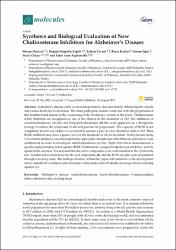| dc.contributor.author | Hussein, Weiam | |
| dc.contributor.author | Sağlık, Begüm Nurpelin | |
| dc.contributor.author | Levent, Serkan | |
| dc.contributor.author | Korkut, Büsra | |
| dc.contributor.author | Ilgın, Sinem | |
| dc.contributor.author | Özkay, Yusuf | |
| dc.contributor.author | Kaplancıklı, Zafer Asım | |
| dc.date.accessioned | 2019-10-19T14:44:26Z | |
| dc.date.available | 2019-10-19T14:44:26Z | |
| dc.date.issued | 2018 | |
| dc.identifier.issn | 1420-3049 | |
| dc.identifier.uri | https://dx.doi.org/10.3390/molecules23082033 | |
| dc.identifier.uri | https://hdl.handle.net/11421/13516 | |
| dc.description | WOS: 000445295500198 | en_US |
| dc.description | PubMed ID: 30110946 | en_US |
| dc.description.abstract | Alzheimer's disease (AD) is a neurodegenerative disorder mostly influencing the elderly, and causes death due to dementia. The main pathogenic feature connected with the progression of this multifactorial disease is the weakening of the cholinergic system in the brain. Cholinesterase (ChE) inhibitors are recognized as one of the choices in the treatment of AD. The inhibition of acetylcholinesterase (AChE) and butyrylcholinesterase (BChE) were approved as a therapeutic strategy to reduce the symptoms of AD and prevent its progression. The capacity of BChE is not completely known yet; rather, it is accepted to assume a part in a few disorders such as AD. Thus, BChE inhibitors may have a greater role for the treatment of AD in the future. In the present study, 2-(9-acridinylamino)-2oxoethyl piperazine/piperidine/morpholinecarbodithioate derivatives were synthesized in order to investigate anticholinesterase activity. Eight derivatives demonstrated a specific and promising action against BChE. Furthermore, compound 4n showed inhibitory activity against both enzymes. It was found that the active compounds were well tolerated in the cytotoxicity test. Possible interactions between the lead compound, 4n, and the BChE enzyme were determined through a docking study. The findings obtained within this paper will contribute to the development of new and effective synthetic anti-Alzheimer compounds, and will ideally encourage future screening against AD. | en_US |
| dc.description.sponsorship | Anadolu University Scientific Projects Fund [1805S191] | en_US |
| dc.description.sponsorship | This study was financially supported by the Anadolu University Scientific Projects Fund, Project No: 1805S191. | en_US |
| dc.language.iso | eng | en_US |
| dc.publisher | MDPI | en_US |
| dc.relation.isversionof | 10.3390/molecules23082033 | en_US |
| dc.rights | info:eu-repo/semantics/openAccess | en_US |
| dc.subject | U Alzheimer'S Disease | en_US |
| dc.subject | Acetylcholinesterase | en_US |
| dc.subject | Butyrylcholinesterase | en_US |
| dc.subject | 9-Aminoacridine | en_US |
| dc.subject | Dithiocarbamate Salts | en_US |
| dc.subject | Docking Study | en_US |
| dc.title | Synthesis and Biological Evaluation of New Cholinesterase Inhibitors for Alzheimer's Disease | en_US |
| dc.type | article | en_US |
| dc.relation.journal | Molecules | en_US |
| dc.contributor.department | Anadolu Üniversitesi, Eczacılık Fakültesi, Farmasötik Kimya Anabilim Dalı | en_US |
| dc.identifier.volume | 23 | en_US |
| dc.identifier.issue | 8 | en_US |
| dc.relation.publicationcategory | Makale - Uluslararası Hakemli Dergi - Kurum Öğretim Elemanı | en_US |
| dc.contributor.institutionauthor | Sağlık, Begüm Nurpelin | |
| dc.contributor.institutionauthor | Ilgın, Sinem | |
| dc.contributor.institutionauthor | Özkay, Yusuf | |
| dc.contributor.institutionauthor | Kaplancıklı, Zafer Asım | |


















